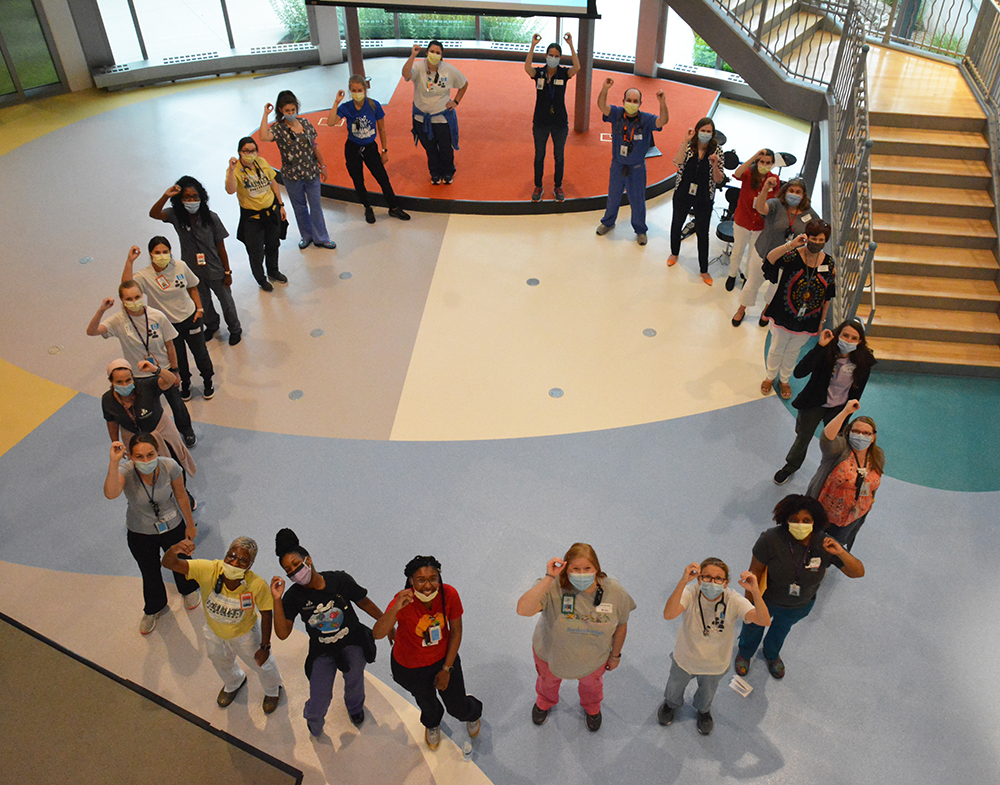While 2020 has been heavy with worry thanks to the ongoing COVID-19 pandemic, the team at Ranken Jordan Pediatric Bridge Hospital has reason to celebrate. The hospital has surpassed a full year—a record—without having a central line-associated bloodstream infection (CLABSI) in any patients.
“This significant achievement is a direct indicator of the high-quality nursing care at Ranken Jordan,” says Melanie Hubert, RN, infection prevention and quality specialist at the hospital.
Ranken Jordan cares for fragile children with complex medical needs. Many of these children have central lines that remain in place for long periods.
A central line is a catheter or small tubing that is placed into a large blood vessel that connects directly to the heart. It allows fluids, medicines or nutrition to reach the bloodstream. These central lines are inserted when an intravenous catheter will be needed over weeks or months.
It can be challenging to prevent central line infections because the line is accessed so frequently to administer medication, nutrition or for blood draws, Hubert explains. “Every time the line is accessed, it’s an opportunity for an infection to be introduced. At Ranken Jordan, it can be even more challenging because children are frequently out of their rooms and are more active.”
Ranken Jordan is committed to the Care Beyond the Bedside approach so the team takes additional steps to keep children safe while they play. This includes seeking better ways to prevent CLABSIs.
“We’re not going to allow a central line from disrupting the ability of kids to play and have fun,” says Kristin LaRose, RN, chief nurse officer. “We feel the benefit of getting kids out of their rooms outweighs the risks.”
Collaborating to Improve Safety
To tackle the issue of CLABSIs, the hospital formed a workgroup that included an infection prevention physician, an infection prevention specialist, nurses on the front line and hospital leadership to identify opportunities for improvement.
The workgroup examined policies and procedures to make sure the most up-to-date, evidence-based practices were followed consistently. Based on research of best practices, the team created a standardized check list designed to prevent CLABSIs. The front line staff tailored the list based on issues they had encountered in their direct patient experience at Ranken Jordan.
Nursing leadership also began visiting patient bedsides to identify any high risks for infection and work more closely with bedside team members.
LaRose says input from the front line staff coupled with the team’s research into best practices were key to driving positive results—preventing CLABSIs. “We created a realistic, doable and comprehensive check list for staff to ensure the right care steps were happening every day, every shift, with every child.”
This is the first clinical outcomes project that included front line staff. “The positive results validated the process we went through,” LaRose says. “Everyone realized the difference we all can make if we’re thoughtful and systematic about how we address an issue. I’m proud of the learning and the journey we took to get here. It’s setting us all up to be successful for future projects.”
“I’m proud of the collaboration from the bedside staff and the ownership they’ve taken for the to see the results of their hard work,” Hubert adds.
LaRose admires the team’s diligence that led to zero infections. “Everyone is so mission focused for the kids here. There’s a lot of personal accountability with all of our infection control practices. The team is vigilant in their care for our fragile patients.”
Positive Results in the Face of Multiple Challenges
The team’s diligence paid off with zero CLABSIs in more than a year—and counting.
The accomplishment is even more remarkable considering in the past year the hospital had the highest number ever—more than 1,700—of days of patients with central lines. The team also cared for the highest number of individual patients (36) with central lines during this time period.
“We had the most central line days ever and the most individual patients with a central line yet we were still able to maintain zero infections,” Hubert says. “To have had as many central line days without an infection is a remarkable feat.”
LaRose points out that the zero infection rate applies to the whole hospital, not just an individual unit in a hospital. “That’s rare for any hospital, but especially considering we care for patients with a range of complexities, diagnoses, and ages from birth to 22.”
Hubert agrees. “Most of our children with central lines at Ranken Jordan are under age 3. This age group is the most difficult to keep the central line safe because they tend to scratch, pull on the line or chew on it. The fact we’re able to keep this young population safe speaks a lot to all of the staff.”
A Cost Savings Bonus
The team’s efforts also impact health care costs. Hubert says the cost of a CLABSI can range from $3,700 to $36,000 per episode. “CLABSIs are costly in health care and can add patient days. So our team has not only done the right thing for patients, we’re also saving the health care system significant money.”
Creating a Culture of Infection Prevention
Because the children at Ranken Jordan play around the hospital, the hospital team is always mindful of keeping kids safe through infection prevention.
In addition to zero CLABSIs, vigorous infection control practices at Ranken Jordan also have meant zero COVD-19 cases in the hospital.
“Through education and communication, prevention is front and center in everyone’s minds at Ranken Jordan,” Hubert says. “That makes an impact on any infection, whether it’s CLABSI or COVID-19.”

